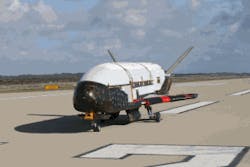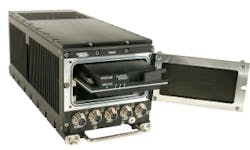Aviation data recorders trending smaller with greater networking capability
By John McHaleDesigners of aviation data recorders for military and commercial aviation say the devices are trending toward improved networking capability and smaller sizes with in a market that continues to offer opportunities. Security -- especially in military flight recorders -- is becoming high priority as well with information assurance requirements being implemented even for unclassified data."I believe the market is trending positive for both military and commercial," says Frank Willis, vice president of military and aerospace systems for Physical Optics Corp. (POC) in Torrance, Calif. "Both verticals are looking for solutions that reduce life cycle cost, but offer a robust level of functionality that help reduce size, weight, and power. Currently, most military platforms do not include a flight data recorder, crash survivability memory unit, or digital data bus connectivity. This translates into opportunities for retrofits and upgrades across the services."The U.S. Navy has released OPNAVINST 13210.1A that updates the policy for incorporation and installation of required avionics safety systems into Navy and Marine Corps aircraft," Willis says. "This includes crash survivable recorders, controlled flight into terrain avoidance, airborne collision avoidance systems and Military Flight Operational Quality Assurance (MFOQA) capabilities using a common solution across all platforms. This is a current issue across all service manned and unmanned platforms."POC's FAERITO recorders are in production for the S-76C++ helicopter, Willis says. The company's Digital Data Set (DDS) is used on the T-45A/C. The DDS includes the data acquisition unit and control panel, which combined provide audio, video, data loading, data recording, data encryption, wireless download, an ED-112 crash survivable memory unit and 128 gigabyte non-volatile memory, he adds."We are seeing the same amount of opportunities [in military and commercial applications]," says Paul Davis of Curtiss-Wright Controls Electronic Systems in Littleton, Mass. "However there have been significant delays in the schedule and execution of these projects. In some cases, the size of the projects has been reduced in scope and size. Projects are being funded with less money initially. So a recorder may change to a reduced number of channels or size of storage. When more budget money becomes available, the recorder and storage will be scaled to meet expanded needs." FAA requirements"The FAA has well defined aviation requirements for the different aircraft type classifications," Willis continues. "Part 119, 121, and 125 define specific aircraft types. The Technical Standard Orders (TSOs) identify specific minimum performance requirements for FAA approval for new data, audio, and video recorders. Given the number of new commercial platforms envisioned to be produced over the next 10 years, this is again an opportunity. "The other area for opportunity is in the general aviation Part 91 classification," he says. "In our discussions with a number of private operators the ability to download aircraft parametric performance data and understanding the overall health of their fleet is a major area of importance. This type of recorder due to the nature of its requirements will be light weight, low cost, and non-intrusive to the platform. This is a new area of opportunity for the recorder industry."Networking capability Enabling network centric capability is major requirement for flight data recorder end users. Networking capability or in other words "addressable equipment with maximum configurability" is what they are looking for, Willis says. This includes Ethernet protocol with an IP address and subnet mask that is changeable according to the platform requirements, he adds."Many new systems are changing to a network centric architecture," Davis says. "The major systems are then sending send data (files) to a network file server."
Curtiss-Wright offers network-centric capability with their Compact Network Server (CNS) and Data Transport support network centric architectures, Davis says. The network attached storage (NAS) devices essentially are files servers that enable central storage to protect data-at-rest through encryption. The removable, mobile storage cartridges also can be adapted to match data demand, he adds.High speed data interfaces for inter avionics equipment communication are also being requested such as Gigabit Ethernet (IEEE 802.3z), Firewire (IEEE 1394), and Fibre Channel, Willis says. Regarding high-speed data interfaces for use as an external data interface to download and to upload the data Willis’s company uses USB 2.0, USB 3.0, eSATA, Firewire (IEEE1394), and high speed wireless interface (WiFi IEEE 802.11n) -- MFOQA enabler, he adds.High resolution data integrity is desired as well due to the "growing capacity of storage and fast processing speeds -- 2 Hz or higher sampling rates for airborne data," Willis says. This "enhances warfighter capability in debriefing and forensic analysis and also significantly increases the maintainability of aircraft."SWaPThe networking capability is also being demanded in smaller and smaller sizes. The need to reduce size, weight, and power (SWaP) drives almost all user requirements for aviation data recorders, Davis says. Along those lines, aviation recorder designers at L-3 Aviation Recorders in Sarasota, Fla., released the L-3 FA5000 solid-state Cockpit Voice and Data Recorder (CVDR). The device is lightweight -- weighing less than 10 pounds -- and is low power, consuming only 8 watts. L-3's CVDR uses four channel, 2-hour high quality audio recording. The lightweight recorder is 6.5 inches in height, 4.88 inches wide, with a depth of 12.6 inches. Its mean-time-between-failure (MTBF) rate is 45,000 hours, according to the company data sheet.L-3 designers get even smaller with their L-3 Lightweight Data Recorder (LDR), which weighs in at under 5 pounds, according to the data sheet. Targeted at general aviation helicopters and fixed-wing aircraft it provides audio, flight data, and image crash-protected recording. It has a height of 4.9 inches, a width of 3.9 inches, and is 8 inches in depth.Information assuranceUsers are requiring information assurance techniques applied to recorders, Davis says. "Even unclassified data is now often being judged to be sensitive. This sensitive data must be secured with FIPS 140-2 methods."The military market is demanding "information assurance security solutions," such as National Security Agency (NSA) "Type 1 and Type B security, for sensitive and classified data management and handling," Willis says.

